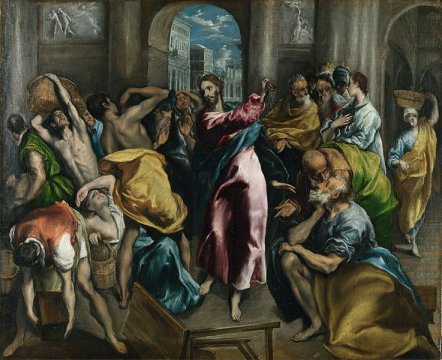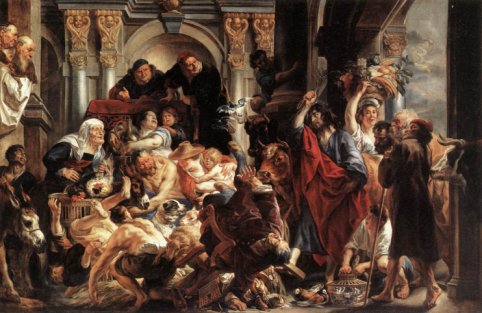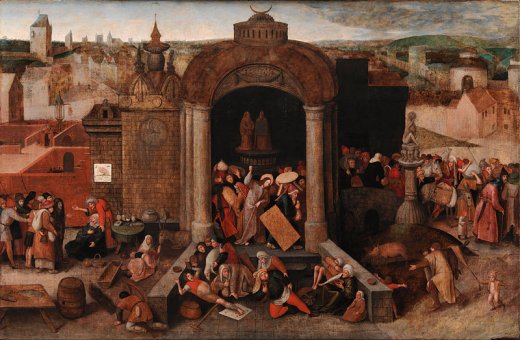|
'And they come to Jerusalem: and Jesus went into
the temple, and began to cast out them that sold and bought in the
temple, and overthrew the tables of the moneychangers, and the seats of
them that sold doves; And would not suffer that any man should carry any
vessel through the temple. And he taught, saying unto them, Is it not
written, My house shall be called of all nations the house of prayer?
but ye have made it a den of thieves. And the scribes and chief priests
heard it, and sought how they might destroy him: for they feared him,
because all the people was astonished at his doctrine.' Mark 11
15- 18
As with the anointing of Jesus, there are chronological
issues with this story. The synoptics make it a part of the events of
the Passion, following the entry into Jerusalem, but John has a
temple cleansing story set very early in Christ's ministry. Some say
John simply misplaced the story; others say that there were two separate
incidents. Bart Ehrman, in Jesus Interrupted, takes the former
view; He suggests, reasonably enough, that a young Jesus would hardly get
away without being arrested for such an action.
I think there are other reasons for placing the single event in
the week of the Passion.
* It beefs up the narrative and gives the high priests
another good reason to 'destroy him'.
* Had he done it before, the Synoptics would surely have mentioned
it.
* John's account does include significant details also included
in the Synoptics - the pigeon sellers, for example; and does refer to
the passion events to come.
The modern take on the story is that Jesus discovered,
within the temple, a cross between a local market and an airport
currency exchange; as if St Peter's in Rome had set aside a chapel for Prada,
Gucci, and so on, to open branches for tourists. This isn't the
case. The sellers of pigeons and lambs were providing animals for
the Passover sacrifice; the visitors to Jerusalem could hardly bring
them with them. And the currency exchange allowed people to change their
own, perhaps Roman currency, into special, sacred coins that could be
used to purchase the animals, or make donations to the temple for upkeep.
All
perfectly above board, and in fact a requirement for Jewish observance
as laid out in the Torah. No more reprehensible, then, than an English cathedral asking
for a donation at the door or running a tea shop.
Theological speculations are many and various and I'm certainly
not going in to them all here. The most common view is that the High
Priests had 'sold out' to the Romans and Jesus wanted to metaphorically
rebuild the temple, or perhaps return Jewish worship to its roots, and
the cleansing was a form of enacted parable. Such a parable would also
prefigure the forthcoming apocalypse of which he preached. Another less exalted view was that the authorities were on the fiddle,
keeping the money rather than making good use of it. None of these
theories explain why the poor old traders had to take the rap.
As with all Passion events, there are references to Old Testament
prophecies, in particular Isaiah Ch 56 6 - 7 and Jeremiah Ch 7 v1,
though some scholars feel these are rather forced. Perhaps more
interesting is the account of the triumphal recapture of Jerusalem
by the Maccabbees in 164 BC, which was followed by a cleansing and
rededication of the temple. This is recounted by Josephus in Antiquities
of the Jews and in the OT apocrypha (1 Maccabees ch 4.) The
parallels would hardly be lost on the history-conscious Jews of the
time, and reinforces the idea of Christ as Messiah and liberator.
This event is rarely found in early art; sadly, Duccio did not
include it in his Maesta. Giotto's fresco in the Scrovegni Chapel, Padua,
is the only pre-fifteenth century example I've located. So why here?
Change 'moneychangers' to 'moneylenders' and suddenly there is a
relevance. Enrico Scrovegni built this 'new temple' to redeem the soul
of his dead father Rinaldo, the notorious usurer.
|




